The crypto and blockchain world is no stranger to big numbers, but 2024’s fee revenue? That’s the next level. Blockchain networks raked in a jaw-dropping $6.89 billion in fees last year, with Ethereum, TRON, and Solana leading the charge. It’s a staggering figure that paints a clear picture: blockchain isn’t just a playground for tech geeks anymore—it’s a booming industry with serious money flowing through its veins.
- Ethereum’s Throne: Still Untouchable
- TRON: The Stablecoin Powerhouse
- Solana’s Meteoric Rise: Meme Coins and Beyond
- Bitcoin: The OG Still Holds Strong
- Layer-2s: The Unsung Heroes
- Blockchain Market in Limbo: What’s Next for 2025?
- Why Blockchain Traders Are Waiting
- The Bigger Picture
- FAQs:
- 1. How much did blockchain networks earn in fees in 2024?
- 2. Why does Ethereum dominate blockchain fee earnings?
- 3. What contributed to TRON’s high fee earnings?
- 4. Why did Solana see such explosive growth in fee earnings?
- 5. How is Bitcoin earning fees beyond its traditional use case?
- 6. What role did layer-2 networks play in blockchain fee earnings?
- 7. Why is the crypto market in a holding pattern heading into 2025?
Let’s break down how this happened, who’s cashing in, and why 2025 might be even bigger (or not) for the blockchain world.
Ethereum’s Throne: Still Untouchable
If blockchain fees were a popularity contest, Ethereum would be the high school quarterback. With $2.48 billion in fees, it didn’t just win the race—it lapped everyone else.
Why? Well, Ethereum is the go-to platform for everything from DeFi to NFTs. Whether you’re swapping tokens on Uniswap or minting that overpriced JPEG of a bored ape, you’re paying a gas fee. And those fees add up. On average, Ethereum pulled in $6.79 million per day last year. That’s like winning the lottery every single day.
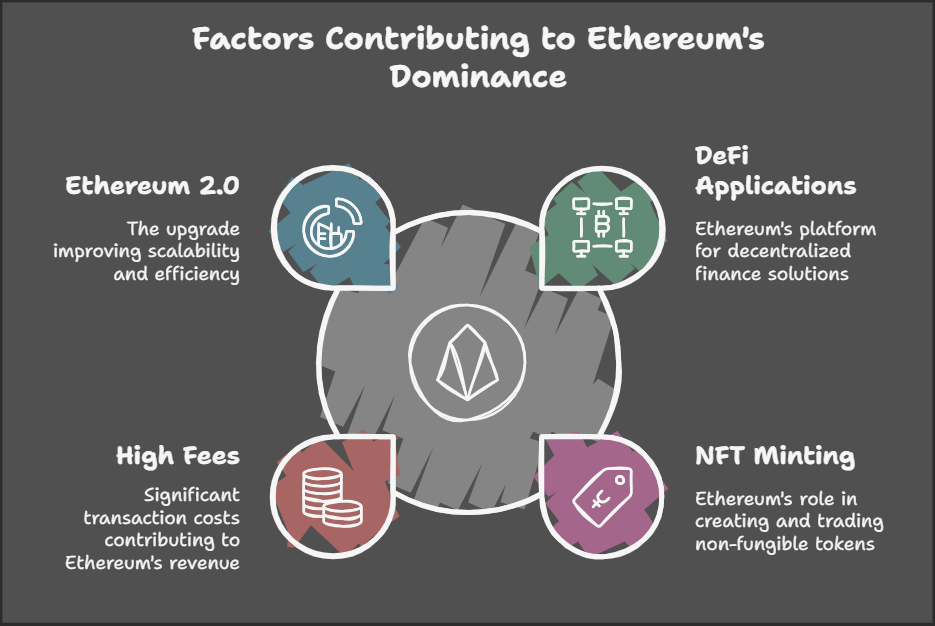
But Ethereum’s dominance isn’t without its challenges. High fees, aka the dreaded “gas wars,” have frustrated users for years. And while Ethereum 2.0 and its move to proof-of-stake have improved scalability, the competition is heating up.
TRON: The Stablecoin Powerhouse
If Ethereum’s the quarterback, TRON might just be the underdog running back. With $2.15 billion in fees, it’s nipping at Ethereum’s heels, and a lot of that success comes from its stranglehold on the stablecoin market.
Stablecoins like USDT (Tether) have found a cozy home on TRON’s network, thanks to its low transaction costs and fast speeds. CoinGecko’s report notes that TRON averaged $5.89 million daily, making it a legitimate heavyweight in the fee department.
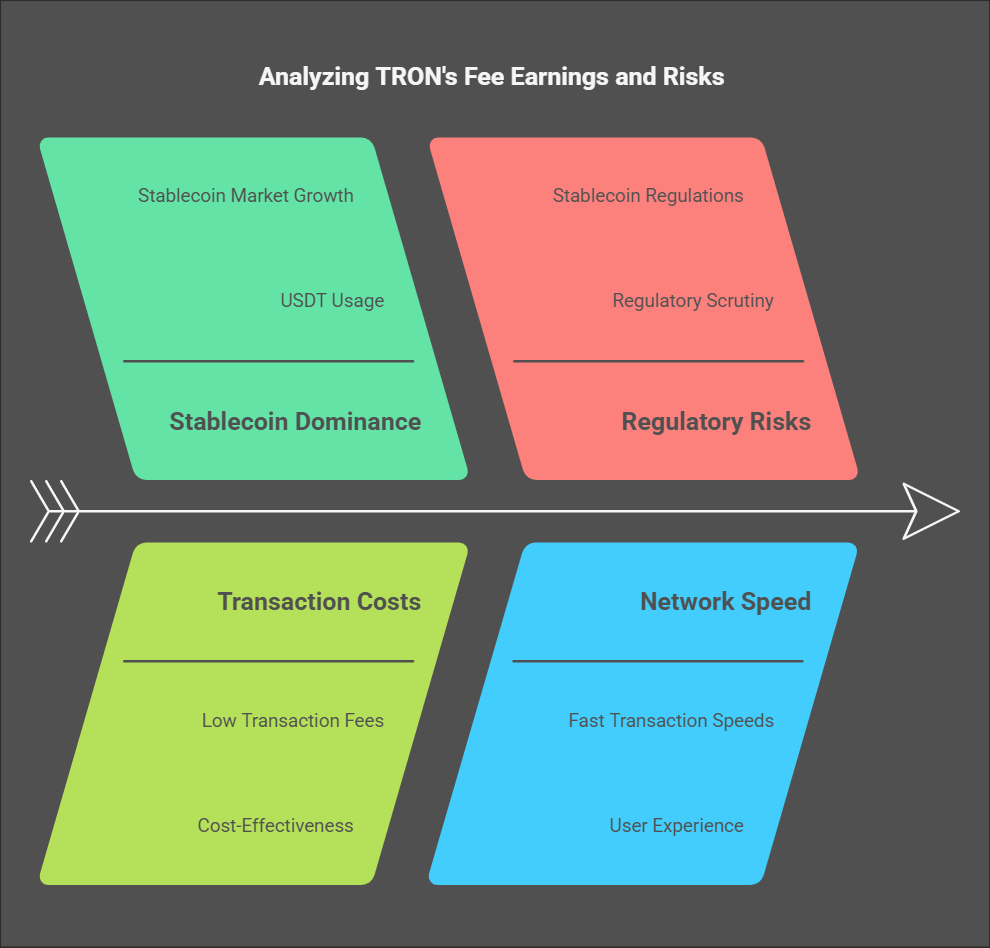
But let’s not sugarcoat it—TRON’s reliance on stablecoins could be its Achilles’ heel. If regulatory scrutiny clamps down on stablecoins, TRON might feel the squeeze.
Solana’s Meteoric Rise: Meme Coins and Beyond
Now, let’s talk about Solana, the dark horse of this fee race. Solana’s fee earnings skyrocketed by an insane 2,838%, reaching $750.65 million in 2024. A lot of this growth is thanks to—you guessed it—meme coins.
Yup, the same coins your buddy Dave bragged about at Thanksgiving after turning $20 into $200. Meme coins exploded on Solana last year, driving activity through the roof. But Solana isn’t just about memes. Its lightning-fast speeds and low fees have made it a go-to for DeFi projects and NFT marketplaces.
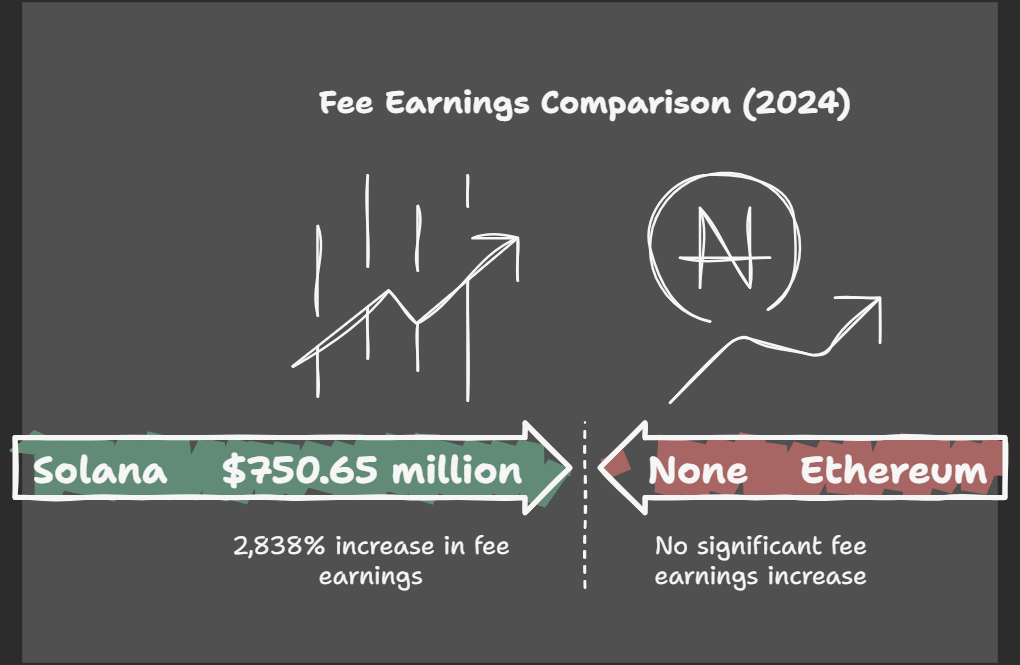
Still, Solana’s rapid growth comes with a caveat: network outages. If it wants to compete with Ethereum and TRON, it’ll need to tighten up its reliability.
Bitcoin: The OG Still Holds Strong
Bitcoin might not be a “smart contract” platform but don’t count it out. In 2024, it earned $922.89 million in fees, up 15.9% from the previous year.
This bump in fees is thanks to some unexpected players: Ordinal NFTs and BRC-20 tokens. Yeah, Bitcoin’s network isn’t just about holding anymore. People are building on it, minting digital assets, and even creating new token standards.
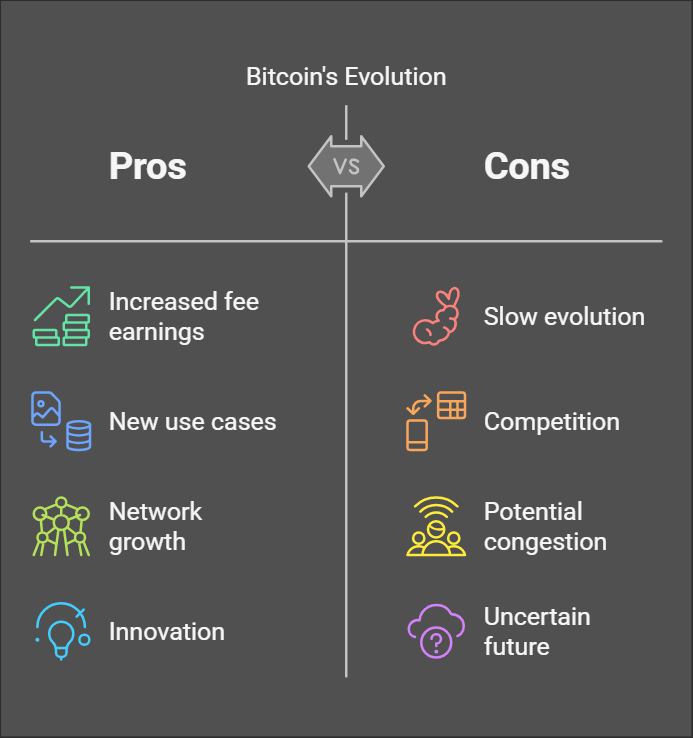
The takeaway? Bitcoin is evolving. Slowly, maybe, but evolving nonetheless.
Layer-2s: The Unsung Heroes
Let’s not forget about layer-2 solutions. These are like the highways to Ethereum’s congested streets. Coinbase’s Base network led the pack, earning $84.78 million in 2024—a mind-blowing 548.2% increase from the year before.
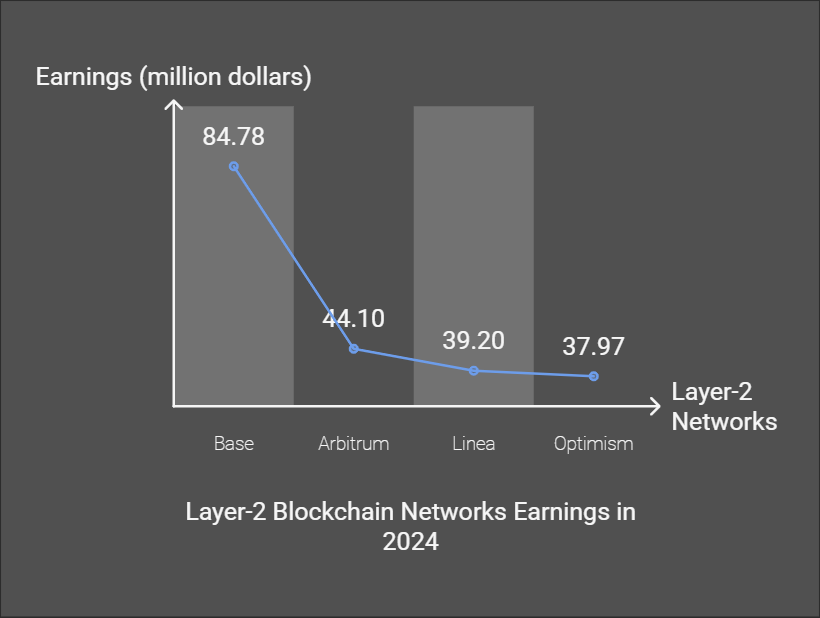
Other layer-2s like Arbitrum ($44.10 million), Linea ($39.20 million), and Optimism ($37.97 million) also made waves. But here’s the thing: a lot of these earnings are tied to token airdrops and incentive programs. The real question is whether they can sustain this momentum without the freebies.
Blockchain Market in Limbo: What’s Next for 2025?
So, where do we go from here? According to analysts at QCP Capital, the crypto market is in a bit of a holding pattern. Why? All eyes are on the Federal Open Market Committee (FOMC) meeting in early February.
The blockchain market has been drifting lower despite the U.S. Securities and Exchange Commission’s (SEC) announcement of a Crypto Regulatory Task Force. Bitcoin ETFs, which were once hailed as game-changers, are seeing reduced inflows. On January 22, spot Bitcoin ETFs saw a 69% drop in inflows, hitting just $248.65 million.
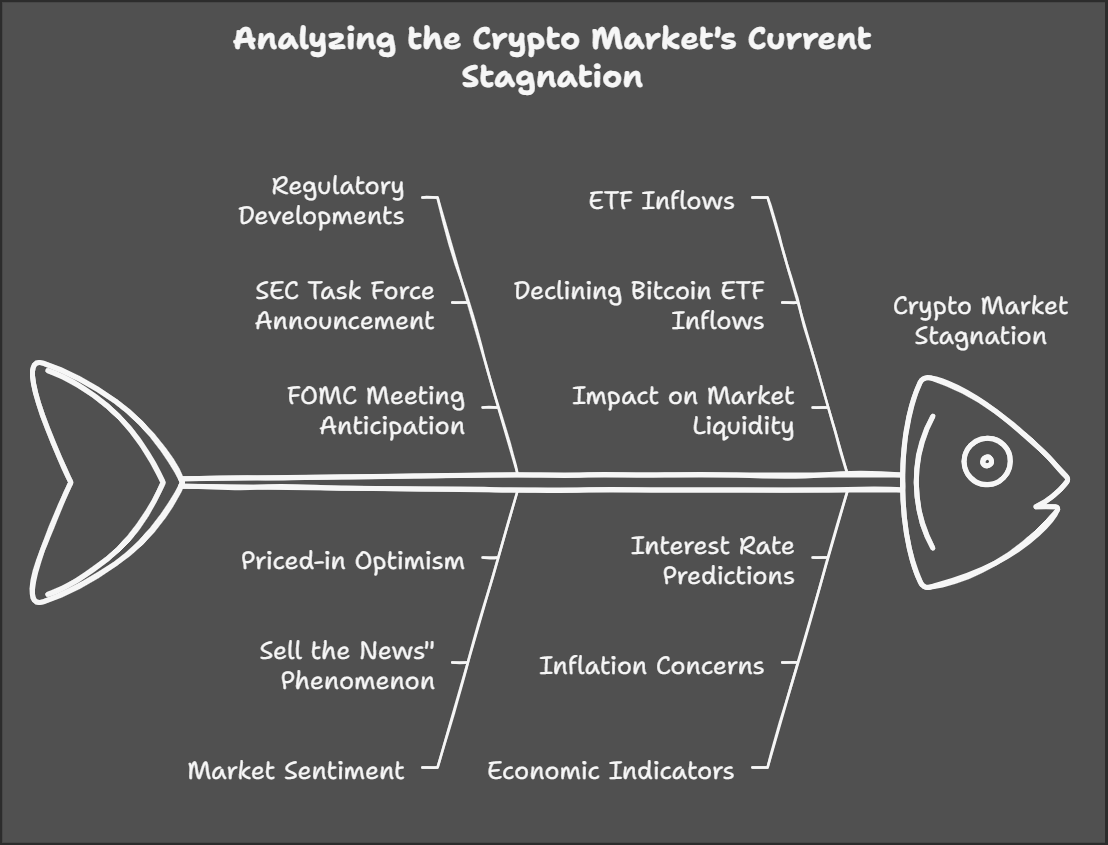
Some experts think this blockchain slowdown might be a classic “sell the news” scenario. Initial optimism around Donald Trump’s presidency, coupled with anticipation for regulatory clarity, could’ve already been priced in.
Why Blockchain Traders Are Waiting
Right now, blockchain traders seem to be sitting on their hands, waiting for a clearer picture. As QCP Capital puts it, “With no major catalysts before next week’s FOMC meeting, the market is likely to remain range-bound until there is more clarity on how the recent weak CPI reading has influenced the Fed’s upcoming policy decisions.”
The Bigger Picture
Looking at 2024’s fee numbers, it’s clear blockchain isn’t a passing fad. It’s a massive, evolving industry. But with growth comes challenges. Ethereum’s high fees, Solana’s network reliability, and TRON’s reliance on stablecoins all highlight the hurdles ahead.
And let’s not forget the looming specter of regulation. As layer-2 solutions gain traction and Bitcoin continues to evolve, 2025 could be a year of big shifts—or more of the same.
For now, though, the blockchain market’s taking a breather. But if 2024 taught us anything, it’s that the next big thing could be just around the corner.
FAQs:
1. How much did blockchain networks earn in fees in 2024?
Blockchain networks earned $6.89 billion in fees in 2024. Ethereum led the charge with $2.48 billion, followed by TRON with $2.15 billion, and Solana with $750.65 million after a massive 2,838% growth.
2. Why does Ethereum dominate blockchain fee earnings?
Ethereum dominates fee earnings because it’s the go-to platform for DeFi, NFTs, and other high-traffic applications. Its daily fee average was $6.79 million in 2024, driven by consistent activity despite its relatively high gas fees.
3. What contributed to TRON’s high fee earnings?
TRON earned $2.15 billion in fees largely due to its dominance in the stablecoin market, particularly USDT (Tether). Its low transaction costs and fast speeds made it a popular choice for stablecoin transactions.
4. Why did Solana see such explosive growth in fee earnings?
Solana’s fee earnings grew by 2,838% in 2024, reaching $750.65 million, thanks to increased activity in meme coins, DeFi, and NFTs. Its ultra-fast speeds and low transaction fees have made it an attractive option for developers and users.
5. How is Bitcoin earning fees beyond its traditional use case?
Bitcoin earned $922.89 million in fees in 2024, up 15.9% from 2023. This growth was driven by new use cases like Ordinal NFTs, BRC-20 tokens, and growing interest in building on Bitcoin’s network.
6. What role did layer-2 networks play in blockchain fee earnings?
Layer-2 solutions like Coinbase’s Base network earned $84.78 million in fees, marking a 548.2% increase. Other layer-2s like Arbitrum, Linea, and Optimism also contributed significantly. These solutions help reduce congestion and lower costs on main blockchains like Ethereum.
7. Why is the crypto market in a holding pattern heading into 2025?
The market is currently “range-bound” as traders await the Federal Open Market Committee (FOMC) meeting in February 2025. Weak CPI readings and reduced inflows into Bitcoin ETFs are contributing to the cautious sentiment.



















































































































